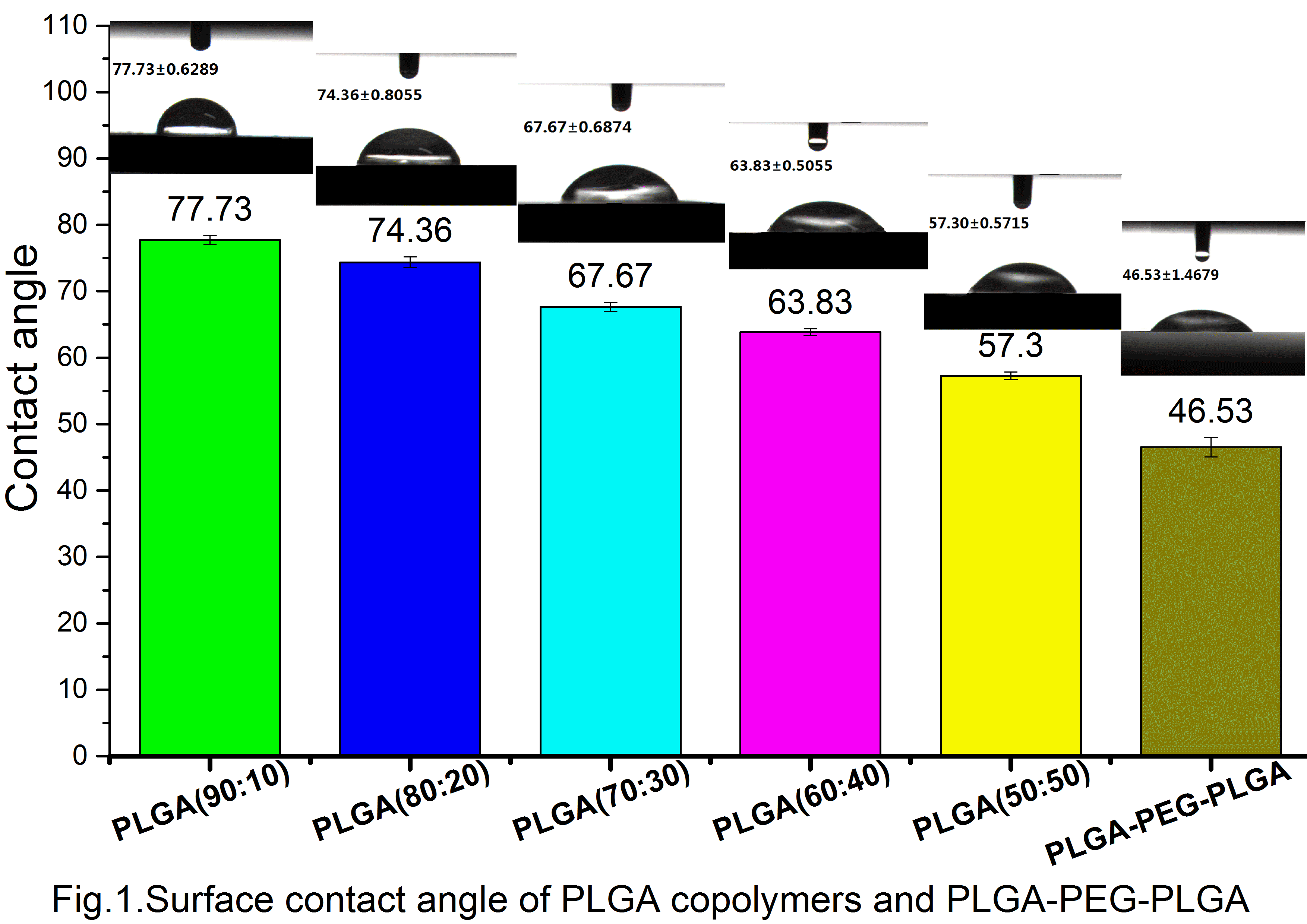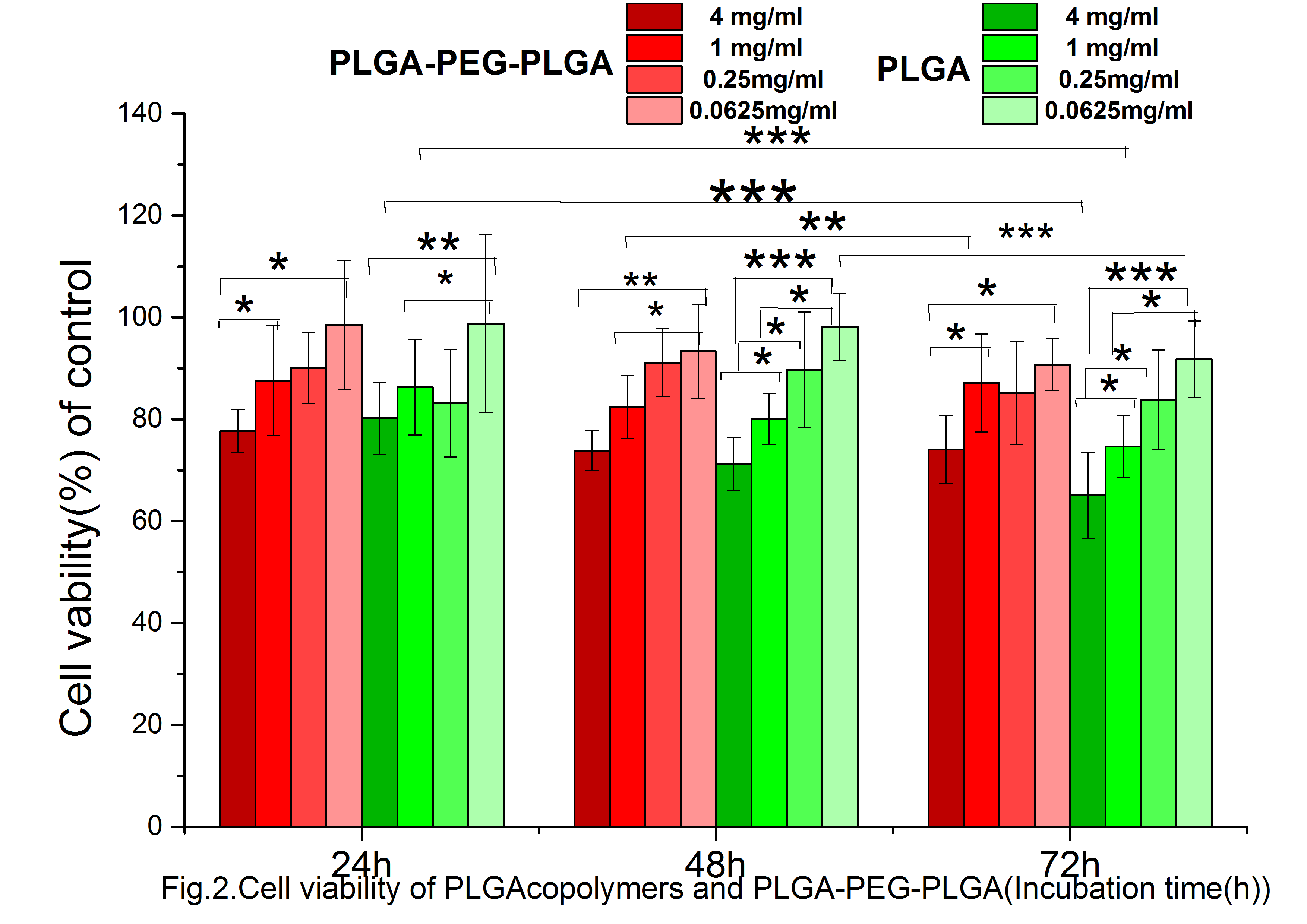Introduction: PLGA has been widely studied due to its good performances such as non-toxicity, high stability and well-defined biodegradable. However, PLGA also has disadvantages including poor ability of hydrophilic and cellular affinity[1]. PLGA-PEG-PLGA(PPP) is a tri-block copolymer composed of PLGA and PEG. PEG block can improve the biocompatibility and hydrophilicity making copolymers has tunable mechanical and degradation properties[2]. Polymeric microspheres delivery systems has become one of most popular areas in the delivery of anti-tumor drugs. PLGA and PPP were demonstrated as two ideal candidate for pharmaceutical applications because of their high biocompatibility and lack of toxicity[3],[4].
Materials and Methods: The PLGA and PEG-grafted PLGA copolymers with different composition ratios were synthesized by modified ring-opening polymerization method. The characteristics of polymers such as (copolymers'composition, thermal behavior,hydrophilicity, crystallization properties and biocompatibility) were studied.
Results and Discussion: Our results demonstrate that the PLGA(LA90:GA10) and PPP show some crystallization properties, while the other four PLGA are amorphous. This suggests that the existence of PEG and enough LA chain segments in copolymers can increase their crystallization. The 1HNMR spectra indicate that the LA and GA monomer ratios in copolymers are very close to the expected theoretical values. The DSC results show that the PLGA copolymers except PLGA(90:10) are amorphous and the Tg increase as the increase of LA contents which may be explained that the LA contents have more polymeric chains.
The surface contact angle measurement indicates that different PLGA copolymers exhibit a wide range of hydrophilic properties and the PPP has the best hydrophilicity for the existence of PEG block. The PLGA polymers with high proportion of LA hydrophilicity is poorer than those with high GA contents. This results enlightened us to obtain the optimal polymers by changing the ratio of raw materials for improving blood compatibility of organisms in the future.

The in vitro cytotoxic evaluation of PLGA(70:30) copolymer and PPP were performed on human neurospongioma using live cell imaging and live/dead analysis assays. Exposure of U251 cells to a range of 0.0625-4mg/ml materials resulted in a small decrease in cell viability. It can be concluded that these two polymers with low toxicity are very suitable to be used as controlled drug release carrier.

Conclusions: The results obtained above showed that PLGA and PPP have a good cell compatibility and easy controlled characters. In summary, these materials are considered as a promising carrier in both hydrophobic and hydrophilic drug delivery system.
the HongKong, Macao and Taiwan Science & Technology Cooperation Program of China (No.2015DFH30180); the Key Grant Project of Chinese Ministry of Education (No.313041); the Key Technology Research Plan of Wuhan Municipality (No.2014060202010120); the Fundamental Research Funds for the Central Universities (WUT:2014-Ⅶ-028)
References:
[1] Cristina Fonseca, Sergio Simoes and Rogerio Gaspar. “Paclitaxel-loaded PLGA nanoparticles: preparation, physicochemical characterization and in vitro anti-tumoral activity.” Journal of Controlled Release. 83 (2002) 273-286.
[2] Khodaverdi E and Mohajeri SA. “Preparation and analysis of a sustained drug delivery system by PLGA–PEG–PLGA tri-block copolymers.” Polymer Bulletin. 69(4) (2012) 429-438.
[3] Lianyan Wang and Mingming Cai. “Polymer hydrophobicity regulates paclitaxel distribution in microspheres, release profile and cytotoxicity in vitro.” Powder Technology. 275 (2015) 77-84.
[4] Guanghui Ma. “Microencapsulation of protein drugs for drug delivery: Strategy, preparation, and applications.” Journal of Controlled Release. 193 (2014) 324-340.